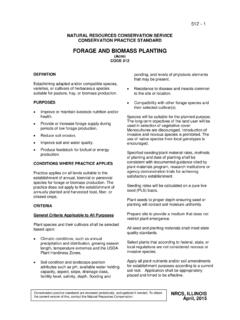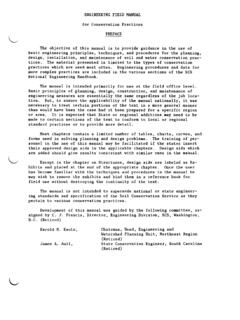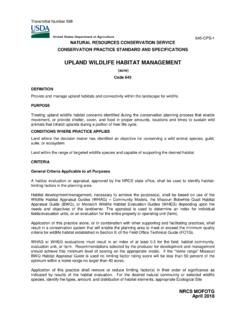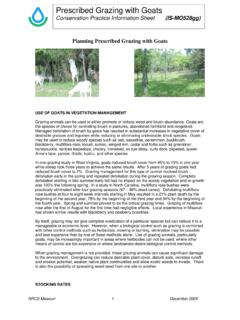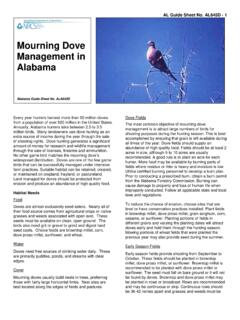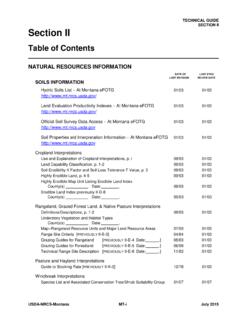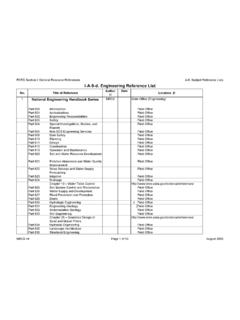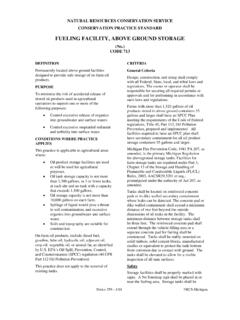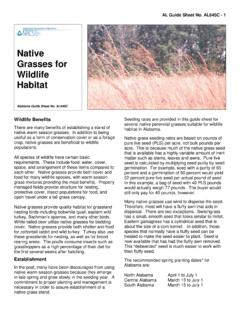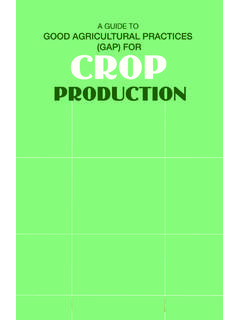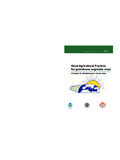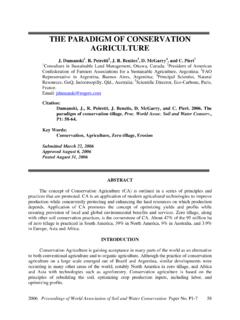Transcription of Minnesota - USDA
1 NRCS MN Alley Cropping 311 Specifications April 2017 Page 1 of 4 Natural Resources Conservation Service Minnesota NRCS ALLEY CROPPING - 311 Conservation Practice Specifications Sheet April 2017 Definition Trees or shrubs are planted in sets of single or multiple rows with agronomic, horticultural crops or forages produced in the alleys between the sets of woody plants that produce additional products. Purpose Enhance microclimatic conditions to improve crop or forage quality and quantity. Reduce surface water runoff and erosion. Improve soil health by increasing utilization and cycling of nutrients. Alter subsurface water quantity or water table depths. Enhance wildlife and beneficial insect habitat. Increase crop diversity Decrease offsite movement of nutrients or chemicals. Increase carbon storage in plant biomass and soils. Develop renewable energy systems Improve air quality.
2 NRCS MN Alley Cropping 380 Specifications April 2017 Page 2 of 4 General Specifications Applicable to all Purposes Woody species compatibility or complementary characteristics include a medium to rapid growth rate, and late spring leaf out and/or early fall leaf drop to maximize sunlight on the alleyway crops or forages. Leaf density is porous or moderate. Avoid woody plants that are allelopathic to crops and forages. Walnuts, hickories, hackberry, black cherry, red oaks, and American elms have known allelopathy. Common crops or forages that may be impacted are: corn, soybeans, sugar beets, oats, fescues, ryes, orchardgrass, timothy, and clover. Root pruning may reduce harm, but leaf decomposition can also have allelopathic chemicals. Choose deeply rooted plants as conditions allow. In general, upland trees are more deeply rooted than wetland trees. Refer to the Field Office Technical Guide, Section II, Conservation Tree and Shrub Groups for selecting suitable alley cropping species for site-soil compatibility.
3 Choose species that can adapt to a variety of soil conditions. If soil conditions change significantly over the length of the row, change woody species as necessary. Use the Conservation Practice Standard Tree/Shrub Establishment (612) for all woody planting requirements. Alley crops or forages will be suitable for the growing conditions, and take into account the changing conditions over time. As conditions change, plan on subsequent crops or forages that tolerate increasing shade, water and nutrient competition. The Conservation Practice Standard Pest Management (595) will be used for all pesticides applications. If water or wind erosion is greater than T, use the appropriate vegetative or constructed erosion control practice as appropriate. Alley Width for Crops or Forages Alley width must be set as multiples of the widest field equipment width. Measure distances of row sets, between trees (if necessary) and diagonally between row sets.
4 Leave at least 4 additional feet than the recommended between tree/shrub row width for equipment purposes. Plan that as the tree crowns spread the alley width must be narrowed, keeping in mind future equipment needs. Tree/Shrub Spacing Spacing Between Rows For multiple row sets, spacing between adjacent rows can vary or be uniform. If plantings are to be cultivated, plan the between-row spacing wide enough for maintenance equipment to operate freely. For a multiple row set, stagger the trees so they do not line-up across the rows. See Figure 1 below. Figure 1. Staggered row spacing for optimal tree growth. Row 1 Row 2 Row 3 Row 4 Row 5 Row 6 Alleyway Alleyway NRCS MN Alley Cropping 380 Specifications April 2017 Page 3 of 4 Spacing With-In Rows Closer within-row spacing is more desirable when managing for wood production ; wider widths are used for nut or fruit production . Use the Conservation Practice Standard Upland Wildlife Habitat Management (645) for spacing recommendations related to specific wildlife species.
5 Spacing guidelines for various purposes are found in the CPS 612. Specifications To Reduce Surface Water Runoff and Erosion When the soil erodibility index >8, use the Conservation Practice Standard Contour Farming (330) or other suitable vegetative or constructed erosion control practices. Vegetative practices such as cover crops are recommended for soil health purposes. If wind erosion is documented, row sets will be placed perpendicular to the most troublesome winds. Use the Conservation Practice Standard Windbreak/Shelterbelt Establishment (380) for more information. The tree row sets will be designed for 40 60% density during the season of the most troublesome winds. Closer within-row spacing is more desirable when managing for wood production ; wider widths are used for nut or fruit production . Use the Conservation Practice Standard Upland Wildlife Habitat Management (645) for spacing recommendations related to specific wildlife species.
6 Specifications to Increase Carbon Storage Refer to the Conservation Practice Specifications Tree/Shrub Establishment (612) for guidelines for the purpose of carbon storage. If using no-till methods for the alley crops, refer to the Conservation Practice Standard Residue and Tillage Management, No-Till (329). Specifications to Develop Renewable Energy Systems Ensure that the trees, shrubs, and alley crops are suitable for biomass production and there is a suitable market available. Refer to the Conservation Practice Specifications Tree/Shrub Establishment (612) for guidelines for the purpose of biomass production . Specifications to Improve Air Quality Use the Conservation Practice Specifications Windbreak/Shelterbelt Establishment (380) for more information. Site Preparation Follow the NRCS Conservation Practice Standard Forest Site Preparation (490) for site preparation guidance. Operation and Maintenance Trees, shrubs, crops, and/or forages will be inspected periodically, at least once annually, and protected from adverse impacts including insects, diseases, damaging wildlife activity, damaging livestock activity, fire or competing vegetation.
7 NRCS MN Alley Cropping 380 Specifications April 2017 Page 4 of 4 All other specified maintenance measures and techniques of tree/shrub establishment will continue until plant survival and establishment are assured. Maintenance measures include replacement of dead and dying trees or shrubs, pruning of dead or damaged branches for safety reasons, periodic pruning of selected branches for control of product quality, and control of undesirable competing vegetation. Refer to the Conservation Practice Standard (612) for survival criteria. Type, use, and timing of maintenance equipment will be appropriate to accomplish operation and maintenance tasks while not damaging or degrading site, existing alleyway crop and woody species and soil conditions. After the fifth year following establishment, woody lateral roots may need to be pruned to keep them out of the alleyway. See Conservation Practice Standard Tree/Shrub Pruning (650) for more information.
8
